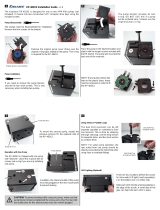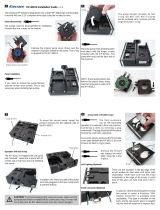
2
In the location where you plan to connect the CCU,
disconnect one side of a NMEA 2000 T-connector
Ã
from the
network.
3
If necessary, connect a NMEA 2000 backbone extension
cable (not included) to the side of the disconnected T-
connector to extend the NMEA 2000 network backbone.
4
Add an included T‑connector for the CCU to the NMEA 2000
backbone by connecting it to the side of the disconnected
T‑connector or backbone extension cable.
5
Route the included drop cable
Ä
to the CCU and to the
bottom of the T-connector added in step 4.
If the included drop cable is not long enough, you can use a
drop cable up to 6 m (20 ft.) long (not included).
6
Connect the drop cable to the CCU and the T-connector.
7
If needed, repeat steps 2 through 6 for the helm control
(optional) or a compatible Garmin chartplotter.
Connecting Optional NMEA 2000 Devices to the
Autopilot System
You can use advanced features of the autopilot system by
connecting optional NMEA 2000 compatible devices, such as a
GPS device, to the NMEA 2000 network.
NOTE: You can connect optional devices that are not NMEA
2000 compatible to the helm control through NMEA 0183
(NMEA 0183 Connection Considerations, page 6).
1
Add an additional T-connector (not included) to the NMEA
2000 network.
2
Connect the optional NMEA 2000 device to the T-connector
by following the instructions provided with the device.
Bleeding the Hydraulics
NOTICE
This is a general procedure for bleeding a hydraulic steering
system. Refer to the instructions provided by the manufacturer
of the steering system for more-specific information about
bleeding the system.
Before you bleed the hydraulic system, you should verify that all
hose connections are complete and fully tightened.
1
Select an option:
• If the helm reservoir contains insufficient fluid, fill it as
needed.
• If the helm reservoir contains excess fluid, remove the
excess to avoid fluid overflow during the bleeding process.
2
Insert a bypass hose between the cylinder bleed ports.
TIP: If you use a clear plastic hose for this bypass, you can
observe air bubbles during the bleeding processes.
3
Manually steer the helm fully to port.
4
Open both bypass valves at the cylinder fittings.
5
Open the bypass valve on the pump manifold.
6
Manually turn the helm slowly to port over three minutes.
TIP: You can stop turning when you no longer see air moving
through the bypass hose.
7
Turn on the autopilot system and disable the Shadow Drive.
You can refer to the autopilot system documentation for more
information on disabling the Shadow Drive.
8
Hold (port) on the helm control for at least 10 seconds.
TIP: You can stop holding when you no longer see air
moving through the bypass hose.
9
Close both bypass valves at the cylinder fittings.
10
Close the bypass valve on the pump manifold.
11
If necessary, add fluid to the helm reservoir.
12
Repeat steps 3 through 11 for the starboard side.
13
Hold (port) on the helm control until steering stops and
Hydraulic Pump Stall is shown on the helm control.
14
Hold (starboard) on the helm control until steering stops
and Hydraulic Pump Stall is shown on the helm control.
15
Select an option:
• If Hydraulic Pump Stall is not shown within 2 to 3
seconds after the cylinder stops, repeat steps 1-15 to
bleed the system again.
• If Hydraulic Pump Stall is shown within 2 to 3 seconds
after the cylinder stops, the system bleed completed
successfully.
After hydraulic bleeding is complete, you can re-enable the
Shadow Drive.
Corrosion Blocker
NOTICE
To ensure the long life of all parts, apply corrosion blocker to the
pump at least twice yearly.
A marine-rated corrosion blocker should be applied to the pump
after all hydraulic and electrical connections are made and the
hydraulic system has been bled.
Configuration
The autopilot must be configured and tuned to your boat
dynamics. You can use the Dockside Wizard and the Sea Trial
Wizard on the helm control or a compatible Garmin chartplotter
to configure the autopilot.
See the included configuration guide for more information on
configuring the autopilot.
Appendix
NMEA 0183 Connection Diagrams
The helm control is not included in all autopilot packages. A
helm control must be installed in your autopilot system to
connect NMEA 0183 devices according to these diagrams. If
you install the autopilot without a helm control, all NMEA devices
you plan to use with the autopilot system must be connected to
a compatible Garmin chartplotter on the same NMEA 2000
network as the CCU. See the installation instructions provided
with your chartplotter for NMEA 0183 connection information.
These wiring diagrams are examples of different situations you
may encounter when connecting your NMEA 0183 device to the
helm control.
NMEA 0183 Connection Considerations
• There is one internal NMEA 0183 input port (RX port) and
one internal NMEA 0183 output port (TX port) on the included
NMEA 0183 data cable. You can connect one NMEA 0183
device to the internal RX port to input data to this Garmin
device, and you can connect up to three NMEA 0183 devices
in parallel to the internal TX port to receive data output by this
Garmin device.
• See the installation instructions for the NMEA 0183 device to
identify the transmit (TX) and receive (RX) wires.
• The device provides one TX port and one RX port. Each
internal port has 2 wires, labeled A and B according to the
NMEA 0183 convention. The corresponding A and B wires of
each internal port should be connected to the A (+) and B (-)
wires of the NMEA 0183 device.
• You must use 28 AWG, shielded, twisted-pair wiring for
extended runs of wire. Solder all connections and seal them
with heat-shrink tubing.
• Do not connect the NMEA 0183 data wires from this device
to power ground.
• The power cable from this device and the NMEA 0183
devices must be connected to a common power ground.
6












